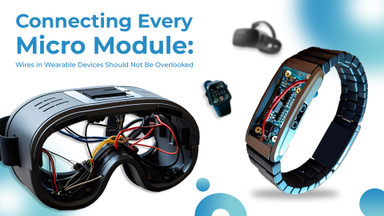Posted by BNTECHGO on 17th Jul 2025
Connecting Every Micro Module: The Essential Role of Wiring in Wearable Devices
As the global wearable technology market surges, internal wiring is evolving rapidly to keep up.
With increasing functional density, the internal architecture of wearable devices is becoming more complex—from signal acquisition and power supply to inter-module communication, every wire plays a critical role.
According to a report by Fortune Business Insights:
In 2024, the global wearable technology market reached $157.3 billion.
From 2025 onward, it is projected to grow from $208.78 billion to $1.695 trillion by 2032, with a compound annual growth rate (CAGR) of 34.9%.
As wearable devices continue to evolve toward being smaller, smarter, and more body-integrated, internal wiring has stepped into the spotlight. Whether it’s fitness bands, medical patches, AR glasses, or smart clothing, all of these rely on stable, flexible, and reliable connections to function seamlessly.
This article breaks down seven common types of internal wiring used in wearable devices, outlining their performance features, application scenarios, and use cases—to help engineers and buyers make informed selections.
1. FPC/FFC (Flexible Printed Circuits / Flat Flexible Cables)
Features: Ultra-thin, bendable, ideal for high-density layouts
Common Applications: Connections between display modules, MCU cores, and touch interfaces
Usage Level: ✅ Widely used (core backbone connections)
? Especially suitable for compact devices, these cables can withstand repeated folding and are among the most widely used interconnects in wearables.
2. Custom FPC Extensions (Flexible Circuit Lead-Outs)
Features: Tailored shapes, flexible routing around complex layouts
Common Applications: Devices with limited space or constrained structural designs
Usage Level: ✅ Moderately used
? Ideal for layouts that require bypassing batteries or routing around housing edges—an extension of FPC applications.
3. Conductive Fiber / Conductive Yarn
Features: Sewable, lightweight, flexible, fabric-friendly
Common Applications: Smart clothing, biometric monitoring garments, smart insoles
Usage Level: ✅ Scenario-specific
? Soft and conformable, making them suitable for wearable sensors in skin-contact areas.
4. Micro-Coaxial Cable
Features: Excellent interference shielding, supports high-speed transmission
Common Applications: Camera modules, RF antennas, data modules
Usage Level: ✅ Scenario-specific
? Common in AR/VR headsets for high-speed video signals and in devices with multiple sensor layouts.
5. Silicone / TPU Wire
Features: Flexible, temperature-resistant, fatigue-resistant under bending
Common Applications: Power input lines, control module connections, signal extensions
Usage Level: ✅ Moderately used
? With outstanding flexibility, these wires are ideal for tight internal spaces and dynamic bending applications.
6. FEP (Teflon) Wire*
Features: High-temperature resistance (200°C+), chemical-resistant, excellent insulation
Common Applications: Jumper wires in health monitoring devices, sweat-prone sensor connections, internal wiring for industrial wearables
Usage Level: ✅ Scenario-specific
? Frequently used in wearables worn for extended periods or in high-moisture environments, where stable power and signal transmission are critical.
7. Custom Wire Harnesses (Integrated Cable Assemblies)
Features: Combines multiple wire types to improve assembly efficiency
Common Applications: Mass-produced wearable products, complex modular devices
Usage Level: ✅ Moderately used
? Ideal for devices with multiple modules and complex structures—such as smart headbands or integrated health monitoring systems.
In wearable devices, it’s not about which wire is the “best,” but rather which one is the most suitable. Each type of wire has its unique role and specialized use case. In real-world product design, multiple wire types are often combined based on layout constraints, functional requirements, and environmental factors—to maximize space efficiency and optimize system performance.
We hope this article has helped you better understand the characteristics and applications of various connection wires used in wearable devices—and choose the right solution for your needs.
BNTECHGO offers a range of wire types commonly used in wearables, including silicone wire, FEP (Teflon) wire*, and more. We support custom sizing and comply with RoHS / REACH environmental standards to meet diverse connection requirements.
? To learn more about our products and services, feel free to email us at support@bntechgo.com or visit our website at https://bntechgo.com.
You can also follow us on YouTube, Facebook, TikTok, LinkedIn, and Instagram—BNTECHGO looks forward to connecting with you!
If you wish to repost this article, please credit the source.






